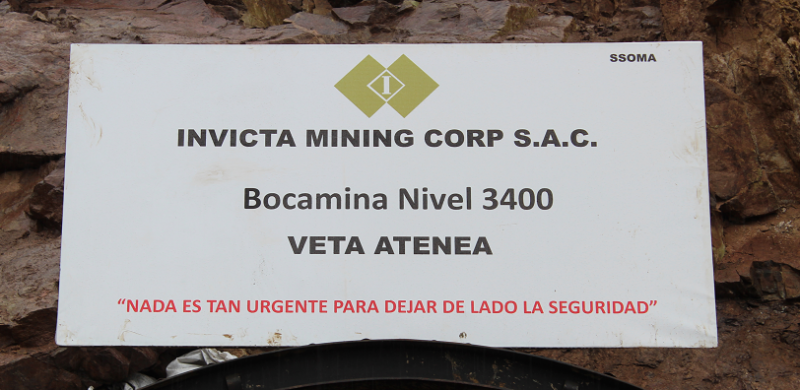
Lupaka Gold Inc. (TSX-V: LPK) has been completing the necessary steps to achieve commercial production at its wholly-owned Invicta Gold project in Peru, located 120 km north of Lima by road. Recently, I had the opportunity to re-visit the mine site to see how work is progressing towards production.
It is at this point in the life span of a mining company where institutional investors typically invest, and the stock price starts to move back up towards full value, which makes it a good time to invest. Lupaka Gold (TSX-V: LPK) is at this point.

With financing secured, the company has commenced construction and development work in order to commence production in the second half of 2018, resulting in potential full appreciation for its shares. The Company’s diligence and hard work is starting to bare fruit through the following recent developments:
- Fully funded to complete its 6 to 12-month goals, including the start of production at Invicta
- Produced a positive PEA on the project with an initial 6 year mine plan
- Community agreement in place
- Commencement of roadwork to mine site
- Building out the in-country team with the appointment of Dan Kivari, P.Eng., as Director of Operations
- Mine rehabilitation and construction
- Ongoing sampling and surveying
The financing secured in 2016 was through Pandion Finance for a total of $7 million (U.S.), available to the Company in three tranches, all of which have now been drawn. This forward gold sale agreement is repayable to Pandion by delivering a total of 22,680 ounces of gold over 45 months.
Pandion plays a partnership role in development by receiving payment in gold from the actual mine rather than by way of equity or traditional debt structures. It also does not dilute shareholders as would with a financing in the market.
With money in place, now begins the real work.
On March 1, 2018, Lupaka issued a preliminary economic assessment (PEA) which outlined low capital expenditures, an initial mining scenario of 350 tonnes per day (tpd), and a very quick payback and path to cash flow. The strategy is to commence mining in an area close to existing infrastructure and focus on a small portion of the resources within the Aetnea vein. While the current Environmental Impact Assessment allows for up to 1,000 tpd, Lupaka’s approach is to start small and gradually increase production over the next few years.
The PEA boasts all-in sustaining costs of $575 per gold ounce equivalent (“AuEq oz”) over an initial six-year mine life and an average annual pre-tax operating profit of $12.3-million ($1300 gold assumption), very attractive economics at current metal prices. There is no need to state the Internal Rate of Return (“IRR”) as it produces meaningful cash flows within the first year.
The updated mineral resource (part of the PEA) outlines 3.0 million tonnes (“Mt”) of Indicated Mineral resources at 5.78 grams per tonne (“gpt”) AuEq oz using a 3.5-gram-per-tonne cut-off, and 0.6 Mt of inferred mineral resources at 5.49 gpt AuEq oz. The initial six-year mine plan is designed on only a portion of the mineral resource (~0.6Mt at an average head grade of 8.58 gpt AuEq, incorporates existing infrastructure which minimizes capital start-up costs.
The company now has over 24 years of tonnage, in terms of Indicated Mineral resources, mining at the 350 tpd, however management’s goal would be to increase production towards the EIA level of 1,000 tpd, which would increase production from 33,700 AuEq oz/yr up to closer to 100,000 AuEq oz/yr.
At the main portal, the company recently announced sample assay values over the footwall vein averaged 9.86 gpt AuEq over a strike length of 130 metres, with an average width of 6.1 metres. The average sampled grades are in-line, or higher, than grades within the mine plan, based on the PEA. With a combined average width of over 12 metres, the sub-vertical Invicta deposit extends for over 130 metres in strike length on the 3400 level and will be immediately accessible for extraction when the Invicta mine becomes operational in the second half of 2018.
The start small approach also allows the Company to reinvest into exploration in surrounding areas, in order to gain confidence to increase the mine plan, and to prove up new resources to potentially extend production for years to come.
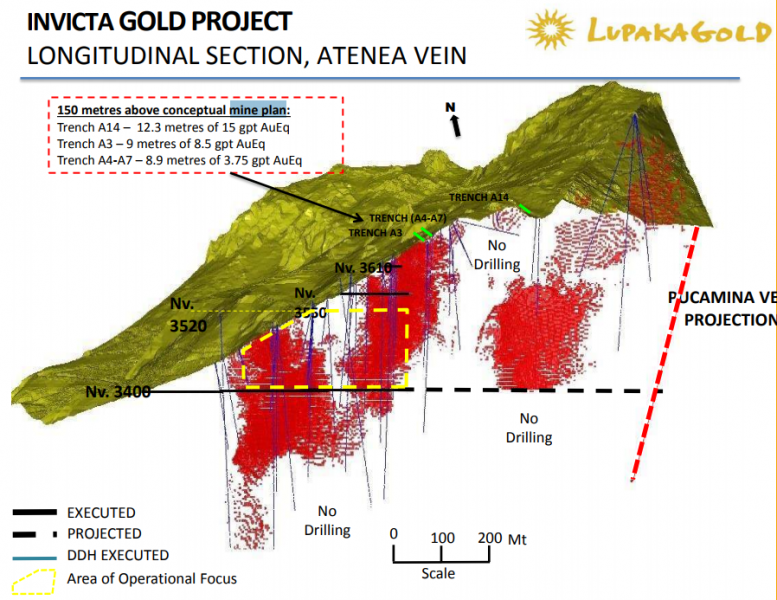
Lupaka has been granted a water use permit from the Peruvian Ministry of Agriculture. Surface rights have been attained, a well has been constructed, and testing studies have concluded it can supply water up to 60 liters per second during the dry season, which should be sufficient supply for an onsite mill in the future.
As part of the agreement that was completed with the community of Lacsanga in July/2017, Lupaka was to undertake and complete certain improvements to the roads, including widening and creation of bypasses around the communities. The company signed a contract with local operators to expand, enhance and modify 27 kilometres of road commencing from the paved Huacho-Churin-Oyon Highway, located at approximately 1,500 metres above sea level, up to the Invicta project located at approximately 3,500 metres above sea level.
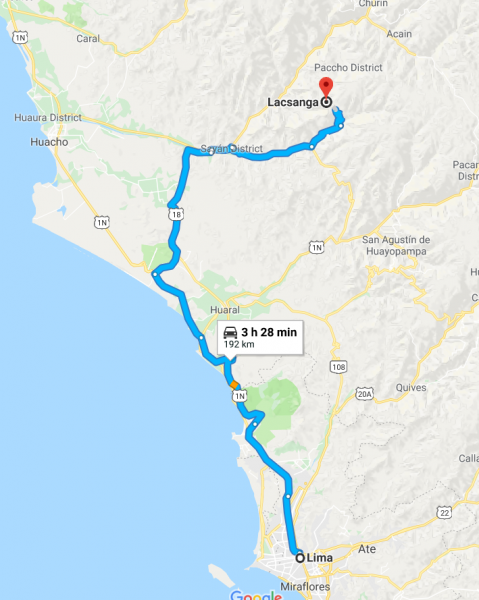
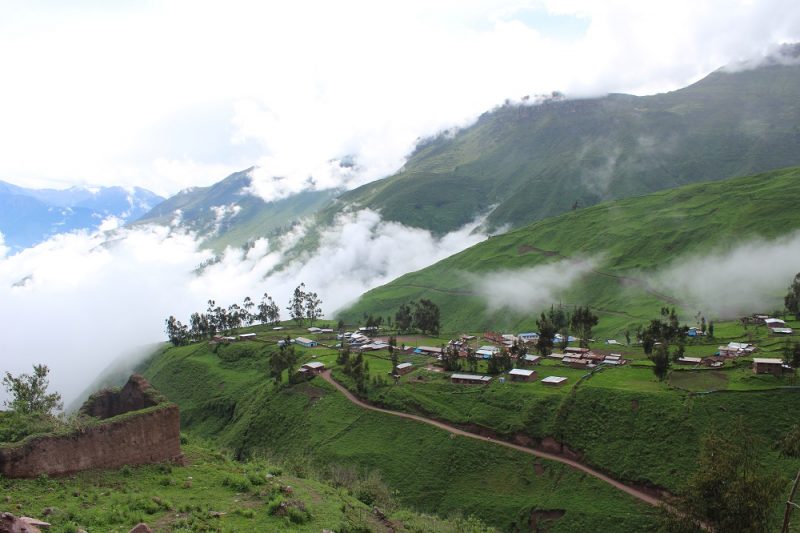
Work is ongoing to ensure that 30-tonne trucks can operate safely and efficiently using North American standards. This involves proper safety berms, passing stations, water drainage, widening hard rock areas using explosives and community by-passes routes.
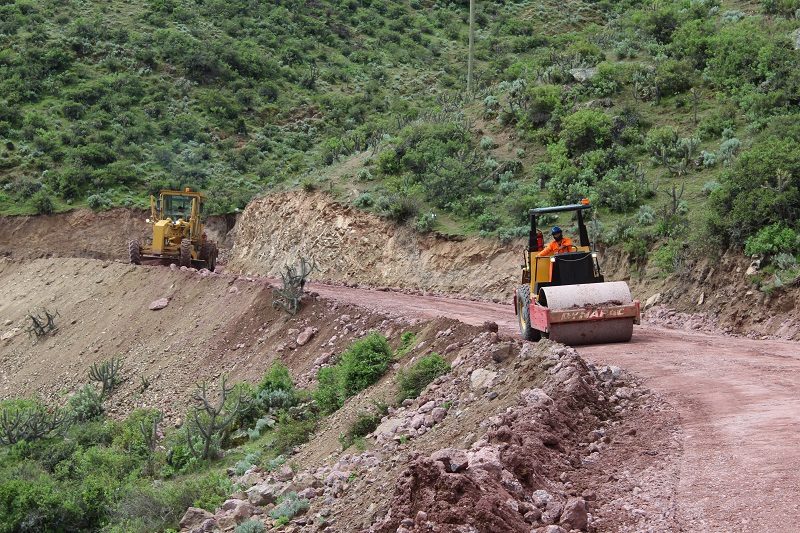
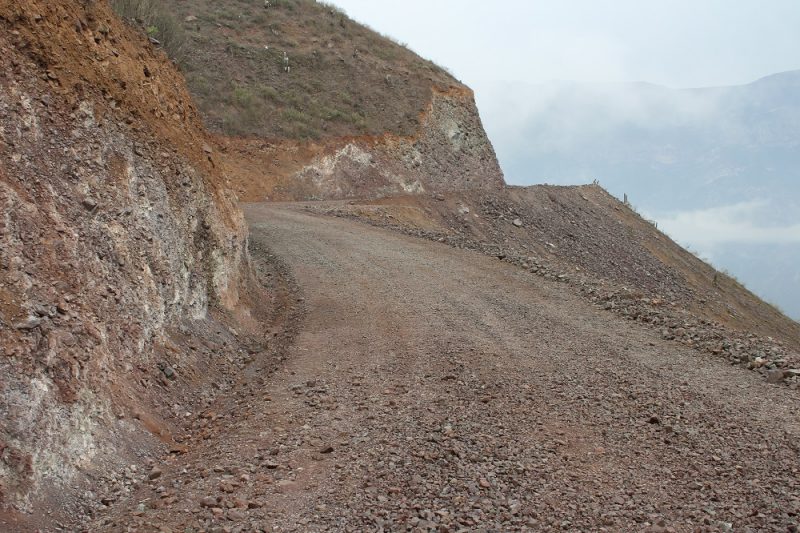
There is a camp to house workers on site that was built by previous operators. It currently can house about 60 to 70 people, but it is already looking like they will have to expand the camp to accommodate a growing team.
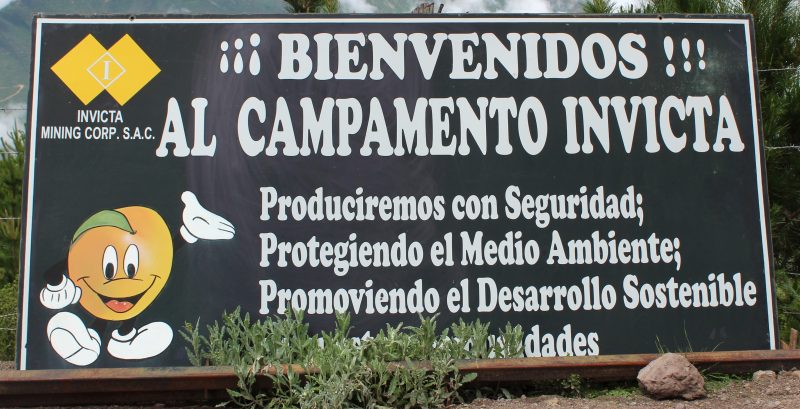
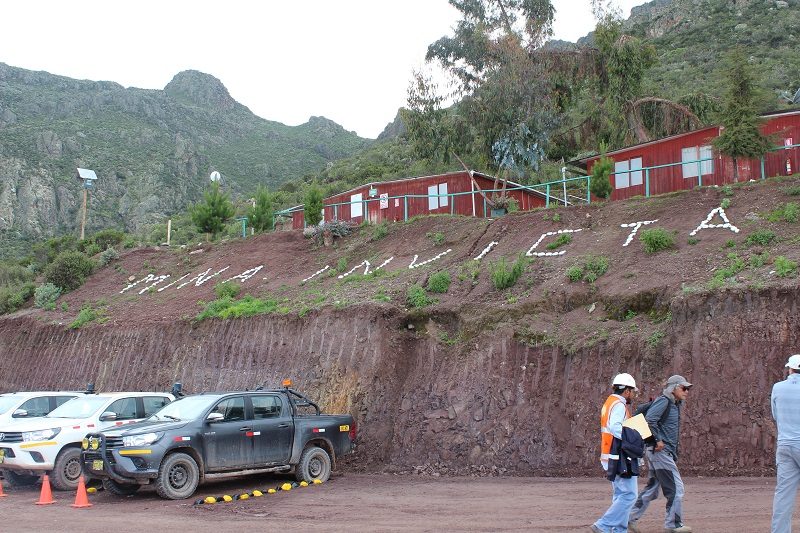
Lupaka announced that development would begin with rehabilitation, preparation at Invicta with three crews, a new adit and 3430 level to be constructed. The Invicta project has approximately of 1.2 kilometres of existing adits, cross-cuts and underground workings.
As you can see below, the cross cut at the 3430 level is in the process of rehabilitation and construction. Over the past few months, work has been advancing to the point the cross cut has approached the main vein wall. Two 4.2-yard PLH Scoops have arrived on site along with a single boom jumbo drill in preparation of accelerated development and stope preparation.
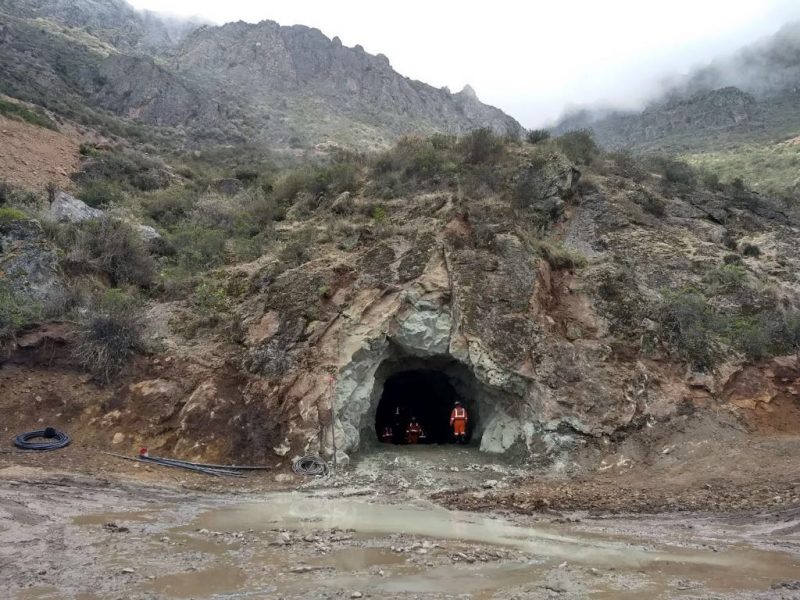
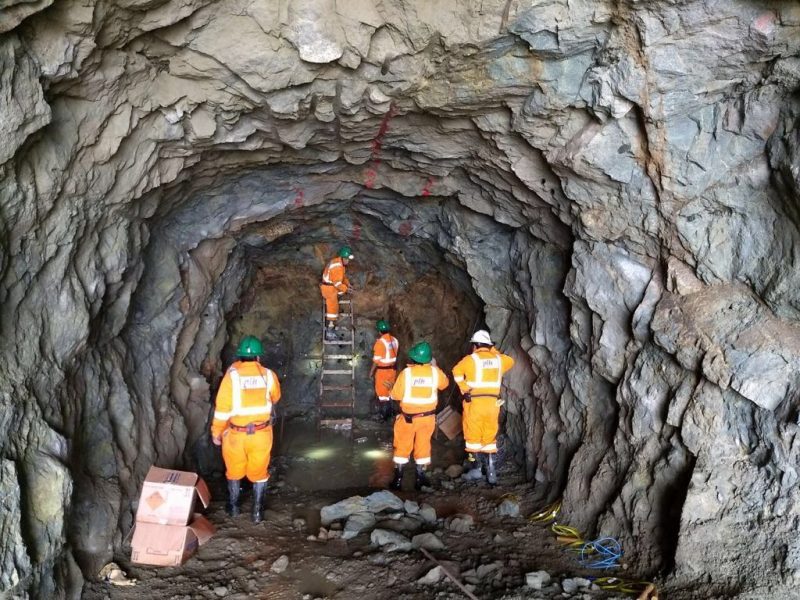
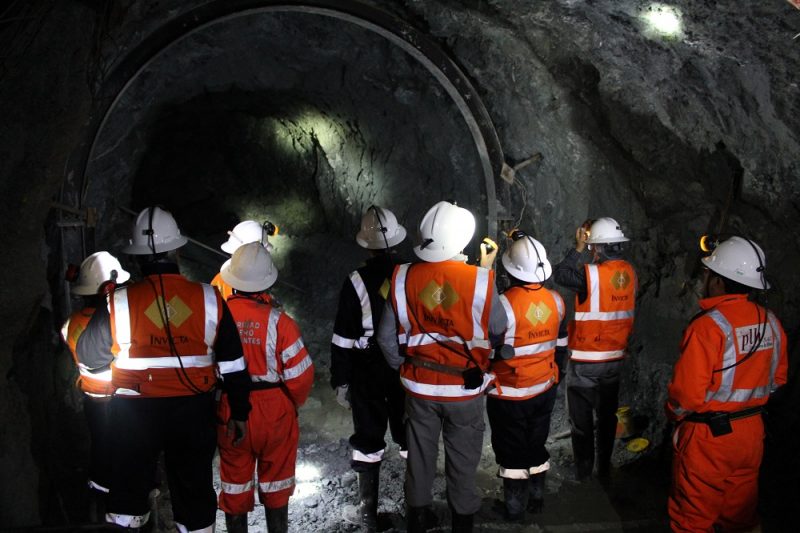
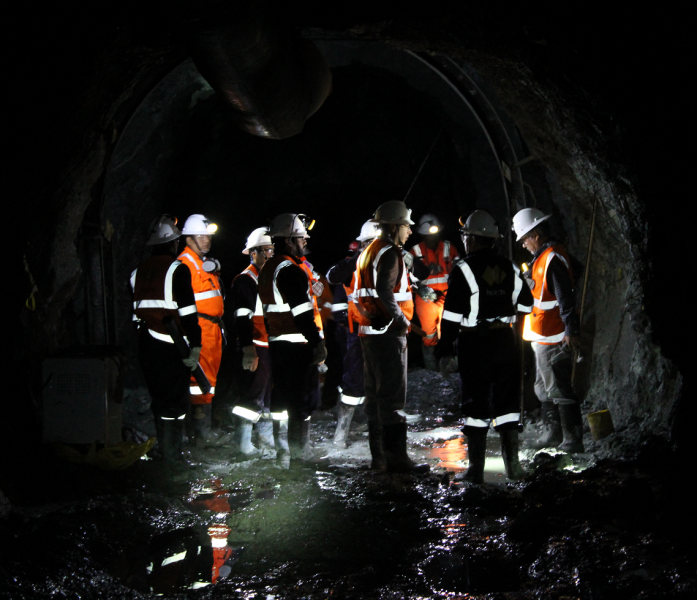
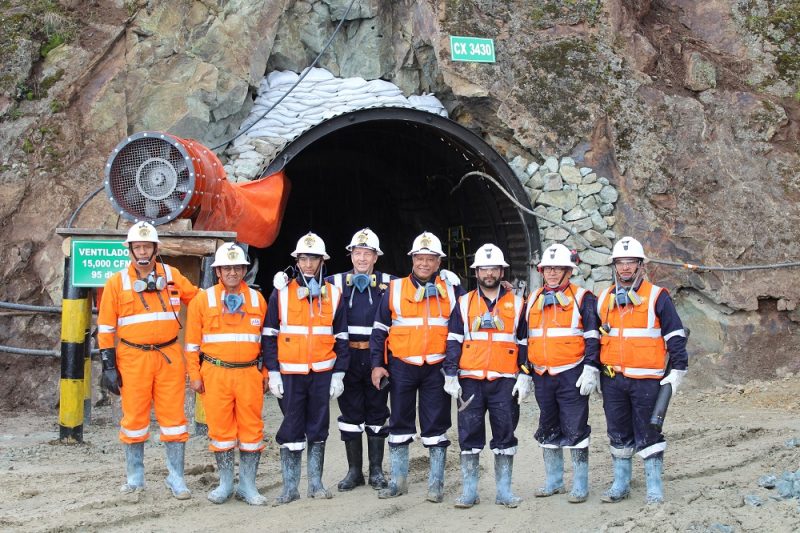
At the lead of operations on site is recently appointed Dan Kivari, P.Eng. (picture in the centre above). He has more than 30 years of international experience in metallurgy, engineering and management of mineral projects throughout various stages of development. Most recently, Mr. Kivari held the position of chief operating officer at Stellar Mining Corp., a privately held mining company in Peru.
Mr. Kivari’s previous work experience includes several senior operating roles such as regional manager for Agnico Eagle Ltd.’s Western and Nunavut operations, where he was responsible for the development of the Meadowbank gold project, and vice-president of operations with Yamana Gold (TSX: YRI) overseeing the development of the Chapada copper-gold project. Throughout this experience, he has picked up the skills necessary to build a team for the Invicta Project.
There is still plenty of work to be done to meet the company’s goal to de-risk and evaluate the suitability of a plant by the second half of 2018. New bulk samples need to be extracted and sent to toll milling facilities to test and optimize metallurgical recoveries and concentrate quality.
A previous run-of-mine bulk test in February 2016 achieved good recoveries in concentrate streams — returning 87.5% gold, 91.2% silver, 91.5% copper, 90.03% lead and 90.1% zinc. The sample was a blend of approximately 80% run-of-mine material and 20% from a low-grade stockpile derived from development.
Looking forward, the company and the geology suggests that there is plenty more to be mined and there is the potential for the construction of a mill which would further reduce the company’s costs and improve any future valuation of the Invicta mine.
From six months ago, the Invicta Gold project is now a completely different scene. Today the roads have and continue to be widened (making them safe), staff and operating equipment is on site and the newly created 3430 Level cross cut has hit the main zone of mineralization.
From an investors perspective, mines moving to production present the greatest investment opportunity because each advancement the company makes de-risks the project and it becomes a question of the operating team to achieve goals on budget and proving the business model works. Lupaka is at this stage and its shares present an opportunity right now.
The hard work is underway at Invicta and the team is already in place to bring it into production, just in time for improving metal prices and the renewed interest in gold. The company appears to be well positioned to bring the project online during the second half of 2018 and meet its objective of becoming cash flow positive in its inaugural year.
Investors can look forward to the following positive catalysts:
- Bulk sample results from prospective toll mill facilities
- Toll milling agreement
- Offtake agreement
- Exploration plans and results
- Obtaining commercial production at 350 tpd
- Engineering and trade-off studies for building a plant onsite
With an all-in-sustaining cost of $575 per AuEq oz over initial six-year mine life, and plenty of resources not yet announced with permits in place to increase production, Lupaka Gold (TSX-V: LPK) is a company to watch.
It is at this stage where investors could see the greatest share price appreciation as the company is on task and working towards becoming a producing gold mine.
Lupaka Gold Inc. (TSX-V: LPK)
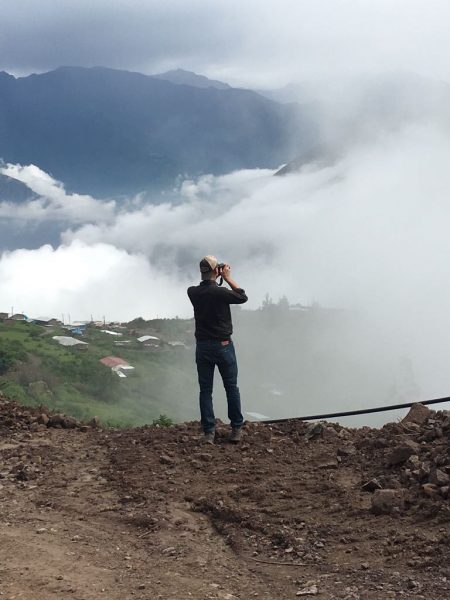
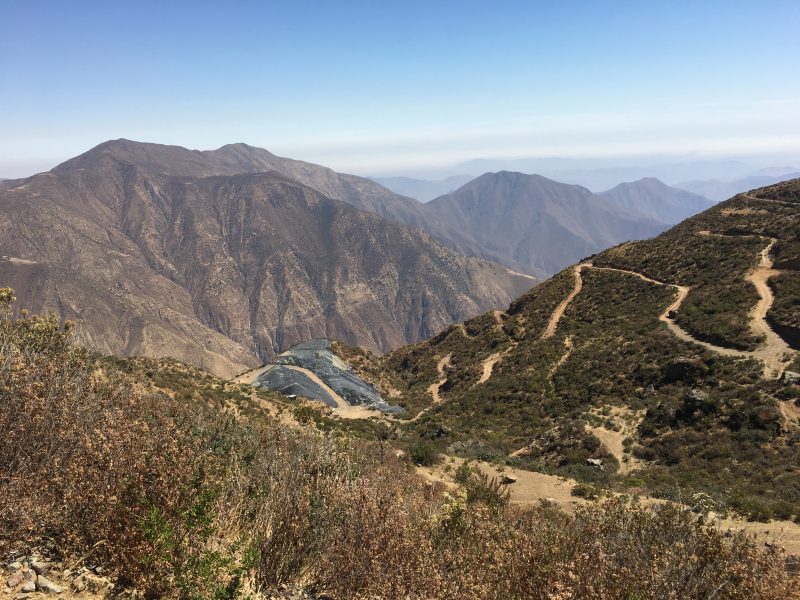
With the recent close of the sale of the company’s Crucero property to GoldMining (TSX-V: GOLD), Lupaka Gold Corp. (TSX-V: LPK) has secured the funds to take the next step with its Invicta Gold project. Today, the company announced the commissioning of a Preliminary Economic Assessment “PEA” for the Invicta Gold Project.
With the backing of Pandion Finance and its gold purchase agreement providing the necessary funding, Lupaka is motivated to meet its obligations which makes now an exciting time for the company and its shareholders.
The company has hired SRK to prepare the PEA. This provides a continuity of project knowledge as the project’s 2012 resources estimate was prepared by SRK and the company’s own internal mining studies of Invicta were prepared with assistance from SVS Ingenieros of Lima “SVS”, Peru, a subsidiary of the SRK Consulting Group. The company plans the completion of the PEA technical report in the first quarter of 2018.
The initial six-year mine plan that was developed and prepared by SVS, which outlined ~735,000 tonnes at a grade of ~6.1 g/t AuEq. for 23,000 oz. of gold equivalent a year, according to a rough calculation. The plan was developed from the 3,400-metre level and extends up 120 metres.
Drill results indicated that the mineralization extends at least as far below the 3,400 level as it does above. In addition, there is a well-defined section of measured and indicated directly along strike to the northeast that is within a few hundred metres, and of the same characteristics as the segment in the mine plan.

The first bulk sample in October 2015 produced a copper, lead and zinc concentrate that was sold to an off-taker. The concentrate was exceptionally clean and was absent of any penalty elements, so buyers could pay well for it because they can mix it with less clean concentrate and blend it.
The company completed its second run-of-mine bulk test in February 2016 and achieved good recoveries in concentrate streams — returning 87.5% gold, 91.2% silver, 91.5% copper, 90.03% lead and 90.1% zinc. The sample was a blend of approximately 80 % run-of-mine material and 20 % from a low grade stockpile derived from development.
The bulk sample was processed with the prime objective of producing a saleable concentrate and no effort was made to optimize content of specific metals, according to the company. The resulting concentrate was clean, with few penalty elements which is ideal for sale and blending with other concentrates.
Once in production, the hope is that cash flow from Invicta will be used to grow the operation. There are numerous zones outside of the Atenea vein that contain mineralization, and the targeted Atenea resource could increase, as development offers access to high-grade intercepts and underground drill sites. In addition, based on gold and copper within the under-explored quartz-sulphide vein zones, the company believes the Invicta resource could expand.
At 350 tonnes per day, Invicta could operate for between 10 and 15 years based on the current measured and indicated resource in the Atenea zone. However, the project is permitted to operate at 1,000 tonnes per day and the company would like to increase their resources through drilling, expand operations to the 1,000 tpd rate and build their own mill on site but for the time being will use third party transport and processing contractors. All of this could take production to over 70,000 AuEq. oz/yr, according to a cocktail napkin calculation.
Proceeds from Invicta will also be used for more exploration at its other projects in Peru — Josnitaro which is a whole other story, worthy of an update of its own.
***MiningFeeds was compensated to provide marketing services. As always, do your own diligence. The writer of this article, Nicholas LePan does own shares.
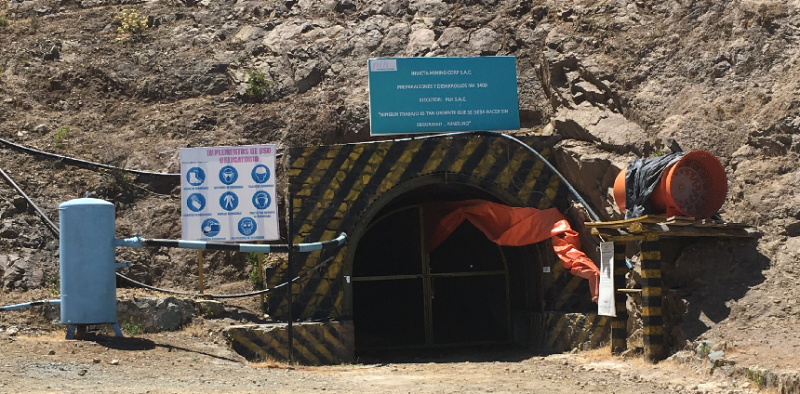
On Nov. 8, 2017, Lupaka Gold Corp. (TSX-V: LPK) received $2 million to further advance its Invicta Gold Project in Peru. This funding was Tranche 2 of the forward gold purchase agreement with Pandion Mine Finance (PLI). This is an important step on the path to production for Lupaka and is an effective alternative to equity financing that links success to production not just share price appreciation.
The receipt of this money satisfied the company’s agreement with Pandion to register the Lacsanga Community Agreement in the Public Registry system in Peru, which was completed on Nov. 6, 2017. These funds will partially go towards the widening of the road up to the site which the company hopes to complete before the rainy season in Peru.
With the registration of the Lacsanga Community Agreement now complete, the only significant conditions remaining to be completed in order to receive Tranche 3 are the requirements to put a mineral offtake agreement in place and to raise an additional US $2 million from other sources.
To meet the conditions for third and final tranche, the company entered into an agreement to sell the Crucero Gold Project to GoldMining Inc. (TSX-V: GOLD) for total approximately $6 million ($750,000 in cash and 3,500,000 shares of GoldMining).
The prepaid forward gold purchase deal with Pandion was announced at the end of June and is an attractive way to finance Lupaka’s Peruvian development project because it is non-dilutive to shareholders and has a fixed end-date.
In an interview earlier this year in the Northern Miner, Chairman of Lupaka Gold Gold Ellis outlined the strategy and benefits of this agreement.
“This is not a royalty agreement that goes on forever…We don’t pay anything for the first 15 months and we only pay them a small percent of what we produce for the next 45 months, and we’re done. It’s gone, it’s clean, there is no residual.”
Furthermore the agreement allows for a 15-month payment holiday which is important as it allows Lupaka the ability to complete development of the mine and ramp up cash flow before having to make any gold repayments.
A prepaid commodity forward agreement is where a buyer agrees to purchase a certain quality and quantity of a commodity from a producer in exchange for an upfront payment. In short, the buyer is acting as a lender in the sense that it is providing money up-front in exchange for future production.
Getting up and running will not be as onerous as other development mining projects as the company plans on using contract miners, contract trucking, and using toll milling facilities.
Tying financing to certain conditions and goals is an excellent way to ensure capital is not wasted on “general corporate purposes” plus tying financing to production is a great way to avoid dilution for shareholders. Lupaka Gold is on the path to production with a clear vision of how to fund and become the next producing mine in Peru.
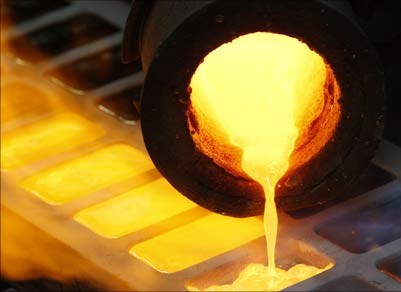
In China, gold production has increased for the eleventh consecutive year. China is the world largest gold producer for the third time in history with 345 tonnes of gold produced this year. Among the top gold-producing countries, China, with its increasing gold production, seems to go against the general trend of decreasing gold production. China has already announced that its gold production is expected to increase to up to 400 tonnes within the next three years.
Of the other major gold producing nations, Australia is the world’s second largest gold producer with a gold production of 255 tonnes in 2010 (+15%). However, this remains 20% below its peak level of production of 1998. In the United States, production of gold has been declining since 1998 (-37%) but has stabilized at around 230 tonnes per year over the last 4 years.
Gold production in South Africa, on the other hand, continues to decline. Until 2006, this country was once the world’s top producer but after almost a century of hegemony its ranking declined to the second position in 2007 and now fourth in 2010. Gold production in South Africa has decreased by 80% within the last 40 years. It is interesting to point out that 2010 Chinese gold production represents only a third of South Africa’s peak production in the late 1960s.
In 2010, Russia maintained its gold production at the same level; about 190 tonnes. While gold production in Peru is still below its peak production of 2005 (208 tonnes of gold) now producing just 170 tonnes of gold in 2010. Although one can identify more than three hundred mines in Peru, more than half of Peru’s production comes from two major gold mines. Indonesia produced 120 tonnes of gold in 2010, down 27% since its peak production in 2006. Half of Indonesia’s production is produced by one single company where production declined by 7% in 2010. And Canada also remains well below its peak production levels (166 tonnes of gold in 1941; and 177 tonnes of gold in 1991) with just 90 tonnes of gold produced in 2010.
The share of small gold-producing countries (Argentina, Bolivia, Brazil, Chile, Colombia, Ghana, Kazakhstan, Mali, Mexico, Morocco, Uzbekistan, Papua, Philippines, Tanzania, etc.) now account for more than a third of world gold production in 2010. This figure was less than 10% in 1969. These days, to find new deposits of gold, mining companies must go deeper into challenging territories such as deserts, rainforests and polar regions.
As a result of lower production costs due to 2008 crisis effects there is a temporary increase in the world production of gold. Since the crisis, global production increased by 240 tonnes reaching 2,500 tonnes in 2010 but short of the peak gold production reached in 2001 of 2,600 tonnes. But going forward, in the next 10 or 20 years, gold production will almost certainly decrease because of the lack of quality gold reserves.
For the original article, CLICK HERE.
From the article entitled, “World Production of Gold, 2011” by Dr. Thomas Chaize author of the Mining and Energy Newsletter. The information provided herein has been provided to MiningFeeds.com by the author and, as such, is subject to our disclaimer: CLICK HERE.
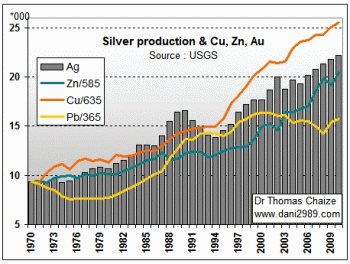
World production of the gray precious metal rose again in 2010. Silver, unlike gold, has seen production levels increase since 2003. This difference in production between gold and silver is not a coincidence due to geology and the history of their production.
World production of silver in 2010 was 713 million ounces. Silver production increased by 1.8% since 2009, 59.7% since its low in 1994 and 161.9% since 1968. In comparison, gold production increased by 8.7% since 1994 and 70% since 1968. World production of silver in 2010 has naturally increased with the increase in the combined production of copper, zinc and gold. This increase has resulted, somewhat mechanically, from the increased production of other metals around the world. Over two thirds of the production of silver is not from primary silver mines but from mine bi-products that produce zinc, copper, lead and gold.
World production of silver by country.
In 2010 Peru remains the world’s number one producer of silver. Silver production in Peru was 123.7 million ounces this past year, down by 1.3% when compared to 2009. The main silver mine in Peru produced 14.9 million ounces (12% of silver production in Peru). The mine is a primary copper mine which also produces silver. The second largest silver mine in Peru produced 10 million ounces (8% of silver production in Peru) and the third 8.6 million ounces (7% of silver production in Peru). The first three mines produce a quarter of the country’s silver, the rest is supplied by more than 140 mines.
Mexico is the second largest producer of silver in 2010. Production declined slightly from 114.1 to 112.5 million ounces of silver. The first number one mine in Mexico produced 35.9 million ounces of silver in 2010, one third of the country’s production and 5% of world production of silver in 2010. This mine is the second biggest silver mine in the world and also produces gold, lead and zinc.
China, number one in zinc, lead and gold, is the third largest producer of silver. China’s silver production continues to grow in 2010, up from 93.2 to 96.4 million ounces of silver. The largest silver mine in China (limited information available so no assurances on this data) is also a wealth of zinc and lead and accounts for only 4-5% of national production and 0.6% of world production.
Australia, number two in lead and gold, is the fourth largest producer of silver with 54.6 million ounces produced in 2010. Australia has the largest silver mine in the world. The mine also produces zinc and lead but is primarily a silver mine. Australia’s largest silver mine produces two thirds of the silver the country and accounts for 5.2% of world production of silver.
Chile, number one in copper, is the fifth largest producer of silver with 48 million ounces of silver produced in 2010. The leading silver mine in the country is also the world’s largest producer of copper, it extracts a quarter of silver production in Chile.
Russia is the sixth largest producer of silver in the world with 45 million ounces of silver produced in 2010. One third comes from a single mine that also produces gold with silver.
Bolivia is the seventh largest producer of silver with 43.7 million ounces of silver in 2010. The main silver mine in Bolivia produced 6.7 million ounces of silver in 2010.
The USA ranks eighth in silver production with 41.1 million ounces of silver produced in 2010. The largest U.S. silver mine, located in Alaska, is also the eighth largest silver mine in the world. It represents 17% of the silver from the U.S. and also produces zinc and lead.
Poland is the 9th largest producer of silver with 38.5 million ounces of silver. 100 percent of Polish production comes from from one mine that also produces copper.

Of these nine countries, the only leading silver mine that produces exclusively silver is from Bolivia. For all the other top silver producing countries, the largest silver mine also produces either copper, zinc, lead, molybdenum or gold.
As noted above, two-thirds of silver production is not derived from primary silver mines, rather from mine bi-products that produce silver along with copper, zinc, gold, lead, molybdenum, or even uranium (in Australia).
It is for this reason that the future of silver production depends to a large degree, almost half, on the production of zinc and copper. While the price of silver is often put in parallel with that of gold, its production depends primarily on the production of base metals. Therefore, the peak production of silver will probably happen at the same time as copper and zinc.
From the article entitled, “World Production of Silver” by Dr. Thomas Chaize author of the Mining and Energy Newsletter. The information provided herein has been provided to MiningFeeds.com by the author and, as such, is subject to our disclaimer: CLICK HERE.
If you would like to receive our free newsletter via email, simply enter your email address below & click subscribe.
CONNECT WITH US
Tweets
Tweet with hash tag #miningfeeds or @miningfeeds and your tweets will be displayed across this site.
MOST ACTIVE MINING STOCKS
Daily Gainers
 Ratel Group Ltd. Ratel Group Ltd. |
RTG.TO | +60.00% |
    |
ERL.AX | +50.00% |
    |
MRQ.AX | +50.00% |
        |
AFR.V | +33.33% |
    |
CRB.AX | +33.33% |
        |
GCX.V | +33.33% |
        |
RUG.V | +33.33% |
        |
CASA.V | +30.00% |
        |
BSK.V | +25.00% |
        |
PGC.V | +25.00% |
Articles
FOUND POSTS
Arras Minerals (TSXV:ARK) Updates on Elemes Drill Program in Kazakhstan
December 19, 2024
Potential Trump Tariffs Could Reshape Copper Market Dynamics in 2025
December 17, 2024

 Follow us on Twitter
Follow us on Twitter Become our facebook fan
Become our facebook fan







